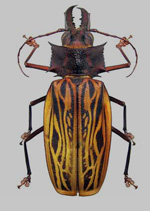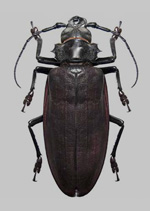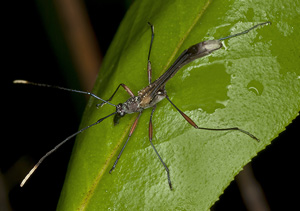The Cerambycidae or longhorn beetles are among the most popular and easily recognised beetles and, for people who are more familiar with insects, mention of cerambycids invokes images of the largest and most iconic species, Titanus giganteus or Macrotoma heros from the Amazon forests in South America. Long antennae and rather elongate bodies are used as general diagnostic characteristics for these beetles. However, longhorn beetles come in all sizes, shapes and colours, even commonly mimicking unpalatable beetles, stinging ants or wasps and thus making scientific definition of the family rather difficult.
Larvae of longhorn beetles are mostly internal feeders, developing in living or dead plant tissues. They are capable of extracting nutrient compounds and microelements from that low energy source, aided by various symbiotic microorganisms and cellulolytic enzymes. They often utilise damaged or dead trees for their development and, through feeding on rotten wood form an important element of the saproxylic fauna, speeding wood decay and energy circulation in woodland habitats. Many species are pests of quarantine concern, attacking and killing forest or ornamental trees, spreading injurious nematodes or, by developing in seasoned wood, causing structural damage to timber constructions.
Evolutionarily, Cerambycidae are members of the Phytophaga, a highly derived group of polyphagous beetles that feed primarily on vascular plants as larvae and adults. This clade comprises Chrysomeloidea (longhorn beetles, seed beetles and leaf beetles) and Curculionoidea (weevils) and includes over 124,000 described species (Ślipiíski et al . 2011). The Phytophaga constitutes the largest known radiation of beetles, a radiation usually attributed to the the co-evolution of these phytophagous beetles and the rapidly radiating Angiosperm plants in the Tertiary (e.g. Farrell 1998). However, this attractive scenario has not been confirmed, at least for Chrysomeloidea (e.g. Gomez-Zurita et al. 2007), suggesting independent radiations of plants and phytophagous beetles driven by as yet unknown forces.
The division of Cerambycidae into subfamilies and tribes was gradually developed along with the first beetle classifications in 18th Century Europe and North America. It was quickly followed by a dedicated monographic study on Cerambycidae by Audinet-Serville, Thompson, LeConte, Pascoe, Lacordaire and Lameere, resulting in division of Cerambycidae into 7 major groups, usually treated as subfamilies: Disteniinae, Parandrinae, Spondylidinae, Prioninae, Aseminae, Lepturinae, Cerambycinae and Lamiinae. The advance of morphological research and use of novel larval characters in cerambycid classification provided support for many traditional groupings but highlighted some new divisions. There is now general agreement that the former Cerambycidae comprises four families, Oxypeltidae, Disteniidae, Vesperidae and Cerambycidae, of which only the largest family — Cerambycidae — occurs in Australia. The Cerambycidae, in this sense, includes approximately 33,000 described species. A large number of new taxa are being added constantly from all over the world but particularly from Asia and South America. The family is cosmopolitan but the largest subfamilies — Prioninae, Cerambycinae and Lamiinae — are most diverse in the tropical and subtropical parts of the world.
Subfamily level classification of Cerambycidae has been very unstable and proposed relationships between recognised subfamilies are mostly based on larval characters alone. Following Švácha and Lawrence (in press) we recognise eight subfamilies in Cerambycidae: Prioninae, Parandrinae, Dorcasominae, Cerambycinae, Spondylidinae, Necydalinae, Lepturinae, and Lamiinae. The Dorcasominae, Necydalinae and Lepturinae have restricted geographical distributions and do not occur in Australia, and the Spondylidinae are represented here only by two introduced species of Arhopalus. Cerambycidae are one of the largest families of Australian beetles, with over 300 described genera and 1,300 species. Yet despite their economic importance and obvious appeal to professional and amateur entomologists, they have been neglected for a long time. Published work on the Australian Cerambycidae has been very fragmentary and mostly limited to isolated species or generic descriptions, often without illustrations or a reference to the tremendous taxonomic difficulties within the generic and tribal classifications of most of subfamilies. The number of genera and species to be treated and the problems in higher classification have been the main impediments to research on this group in Australia. While actively participating in the international team working on higher classification of Cerambycidae that will take many years to publish, we decided to produce an overview and identification keys to Australian genera to facilitate further research on this group.


